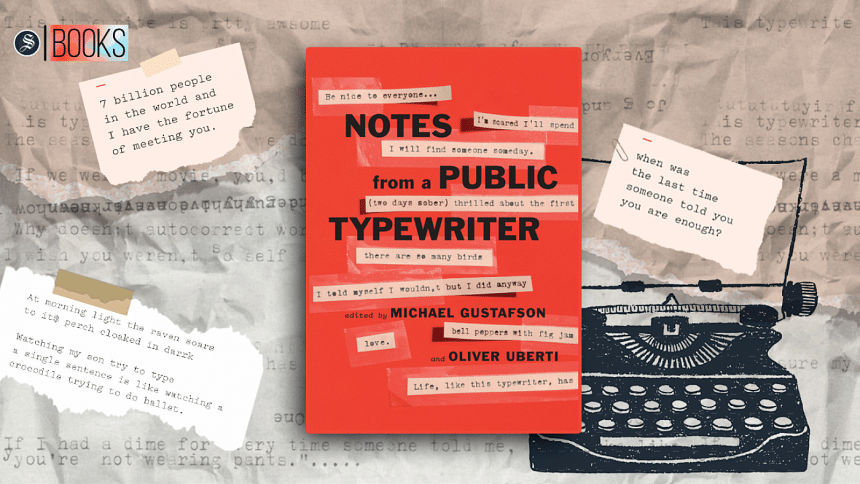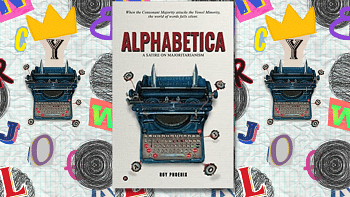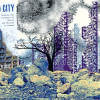When readers write the book

"Typewriters remind us
that words are sound —
they make noise
like the striking of keys
the scratch of pen on paper.
What have we lost now that
words are silent?"
—A note from Notes from a Public Typewriter
In spring 2013, Michael Gustafson and his wife Hilary Gustafson opened a bookstore in Ann Arbor, Michigan, called Literati Bookstore. Their initial dream was to create a community-based, welcoming space in their independent bookstore and share their mutual love for books with everyone around them. After the couple quit their jobs in New York City and decided to move home to Michigan, they signed a lease on their new bookstore, pursuing the shared dream. Committed to working with the local community and supporting them, they repurposed or sourced everything in their store, from bookshelves to the merchandise, locally.
On the bookstore's opening day, Michael decided to set out a light blue Olivetti Lettera 32 typewriter on their bookstore's lower level for anyone to use. After unlocking the door to the public that day, the couple held their breath anticipating every moment. And soon, the store came alive as the wooden floors creaked under the feet of the people walking in one by one. They paged through the store's books, discussed among themselves, and talked about their favourite authors. Among all the creaks and murmurs, Michael Gustafson heard the faint sounds of people typing on the typewriter he had set out earlier that morning. He later shared in the preface of Notes from a Public Typewriter that his initial idea behind this setting was sort of a community-building experiment:
"Before we set out the typewriter, I had a vision that each person who typed a note would participate in a never-ending story, picking up where the last person left off. The plot would twist and turn, the characters would come and go, and, over decades, it could become the Great American Novel—penned by America."
This public typewriter experiment was also a personal experience for him as he first fell in love with typewriters when he came across his grandfather's 1930s Smith Corona. As a struggling writer at that time, this machine was what made writing to him a joyous experience. The Olivetti Lettera 32 typewriter from his bookstore started a new chapter in his life after anonymous note-typers left notes behind every day; people proposed, confessed, apologised, broke up, joked, and philosophised through their short but meaningful writing. Michael also shared how he found the most poignant notes usually on rainy Saturday nights; notes about divorce, sobriety, loneliness. Not all notes left behind held sincerity and some were just gibberish, but after spending hours reading through these anonymously typed fragments, Michael discovered enough impactful writing to keep this experiment going.
He taped his favourite notes to the wall, shared some in store newsletters, and on social media. In 2015, the couple commissioned artist Oliver Uberti to paint 15 of these notes along a 60-feet stretch of their store's building, which is now one of the most photographed locations in Ann Arbor.
Soon after this, their friends, family, the store's customers—everyone started encouraging them to turn all of these notes into a book. So, in 2018, after Michael Gustafson and artist Oliver Uberti had gone through piles of typewritten notes, they finally decided to publish Notes from a Public Typewriter (Grand Central Publishing, 2018)—a book consisting of their most favourite notes, along with essays and photos, as a way to commemorate the typewriter authors. In the book's preface, Michael shared what inspired him to publish these notes:
"Each of us has a note to leave behind, and I realised more of them deserve to be read. They shouldn't be locked inside my filing cabinet at home. Inside our store, surrounded by books that have been laboured over by authors, editors and marketeers, there's a way for people to publish directly into the world in permanent ink— spelling errors and all."
This 160-page book has readers hooked from the get-go with its beautiful, typewritten cover. The notes included in the book resemble the most fundamental human traits and emotions: joy, sorrow, love, hope, despair, gratitude, empathy, humour, and heartbreak.
There is a certain ingenuousness of the black words typed in Courier font on the white, almost blank pages that mirror the anonymous note-typers' whimsy, sentiments, poetic spirit; this unpredictable array of voices is what makes Notes from a Public Typewriter a whirlwind of emotions to the readers. The book's purpose is perfectly captured in its last essay when Michael writes,
"Snap. Click. Clack.
Words will appear on that blank page. Words that cannot evaporate. Words that will stay. Words that will stick around and bring comfort, like the books on our shelves. That's the thing about ink…in all its messy, smudgy, imperfect beauty. Ink lasts."
Mehjabin Biva is an architecture student who thinks someday she will use all the materials she hoarded. Send her Marie Kondo videos at [email protected].

 For all latest news, follow The Daily Star's Google News channel.
For all latest news, follow The Daily Star's Google News channel. 











Comments